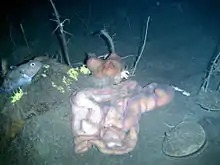Marine worm
Any worm that lives in a marine environment is considered a marine worm. Marine worms are found in several different phyla, including the Platyhelminthes, Nematoda, Annelida (segmented worms), Chaetognatha, Hemichordata, and Phoronida. For a list of marine animals that have been called "sea worms", see sea worm.

Many of these worms have specialized tentacles used for exchanging oxygen and carbon dioxide and also may be used for reproduction.
Some marine worms are tube worms, of which the giant tube worm lives in waters near underwater volcanoes, and can withstand temperatures up to 90 degrees Celsius or about 194 degrees Fahrenheit.
Some worms can live in the trench. These worms[1] were first discovered in the Pacific Ocean off the Galápagos Islands.
In recent years, marine worms (especially those found in the ocean) have been observed ingesting microplastic particles found in the oceans. This trend is concerning many scientists, as marine worms act as an important food source for many fish and wading birds. Marine Worms play as Keystone Species in an ecosystem, and the introduction of plastic in the oceans will not only diminish the growth rates of the marine worms, but also affect the food chain of that ecosystem.[2]
References
- "Giant Tubeworms Probed for Clues to Survival". news.nationalgeographic.com. Retrieved 2018-05-31.
- https://aslo.org/page/limnology-&-oceanography